|
Houses
As a railway works, Wolverton used steam power to run the machines within the Works although no remains have yet been found. It later used gas, being made at the Works and also being piped out to the town. The remains of a gas tower can be seen beside the viaduct at the Park Lodge house end of the Park. In 1900, the first power station was built and the Works notably became the first all electric railway works in the country.
|
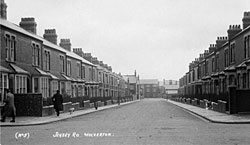 Jersey Road, Wolverton Jersey Road, Wolverton
|
|
Schools and Education
Adult education in Wolverton was originally provided in the form of a small library and reading rooms on the corner of Creed Street and Church Street, where evening classes were encouraged. By 1861, the building was enlarged to include a concert and music hall and lecture rooms. The building reopened in 1864 and was renamed The Science and Arts Institute. By 1891 it was enlarged again to include a gymnasium, a laboratory and additional classrooms. In 1910 a ‘Mechanical Lab’ was added and in 1921 the institute was designated a technical college, the second such establishment in the country. It was demolished in the late 1960s after it was destroyed by fire after being left unoccupied.
Education of children was also promoted, an issue taken seriously by the London and Birmingham Railway Co. In 1839 they built the British Endowed and Infants’ School in Creed Street. In 1840 a school for boys was added. This was later extended to include facilities for girls but the subjects varied greatly. Boys were taught matriculation and technical drawing, girls sewing and craft. All children were taught to read and write. This provision was exceptional as these schools were introduced 30 years before the Education Act of 1871. The school provided for the educational needs of 55 girls and 90 boys in 1847.
The school was extended in 1857 to cope with the increased population and, when the schools moved in 1906 the building was used as an indoor market after the original Market Hall burnt down. It was later converted into its present office use.
There are still four school buildings of the Victorian/Edwardian era surviving in the town A new boys’ school (now Wyvern Nursery School on Church Street was agreed in 1894 and building commenced in 1896, built with money from the railway company, the Radcliffe Trust and town subscription. The adjoining girls’ and infants’ school was approved in 1898, built by the Bucks County Education Committee.
Education for the more academic children was provided by a grammar school, which was located in Moon Street and served the whole of north Bucks. It opened in 1902, on a site known as Three-Bush Field. The building today is occupied by Bushfield Middle School.
|
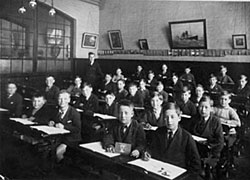 A classroom in Wolverton Boy's School. A classroom in Wolverton Boy's School. |
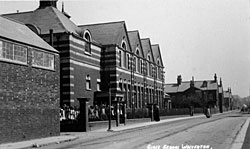 Wolverton Girls' & Infants' School, now Wyvern First School. Wolverton Girls' & Infants' School, now Wyvern First School.
|
|
Churches
There has been a place of worship on the site of the Holy Trinity Church at Old Wolverton for over nine centuries. Holy Trinity Church was a focal point for the community to gather and also for the affairs of the Wolverton estate under The Radcliffe Trustees prior to the arrival of the railway. The medieval church was rebuilt in 1809-1815 in the revived Norman style, incorporating as a west tower, the 14th century central tower with stone conveyed to the site by the new canal network.
In 1840 the London and Birmingham Railway Company proposed that a sum of £1,000 be given to the Directors of the Radcliffe Trust for the erection of a church in New Wolverton. The Radcliffe Trustees agreed to provide land, a parsonage and a fixed income for the parson in addition to paying for church maintenance.
Built in Wolverton Station, as Wolverton was known then, the Anglican church of St.George the Martyr (1843), at the eastern end of Church Street, is said to be the first church in the world to be sponsored by a railway company for the spiritual betterment of its workforce and families, then some 800 people. The nave has seven timber trusses of ‘industrial’ appearance that were probably made in the Works. The graves of railwaymen can be identified in the churchyard.
The Roman Catholic Church of St Francis de Sales, a small building in Radcliffe Street, was built later (1865-7) to serve immigrant Irish railway workers. It is said that it was originally a school: the altar faces north rather than east. The Methodists originally met in the Works Reading Room until their church was built almost on the corner of Church Street and Creed Street in 1892. Its foundation stone mentions the name of C.A. Park, one of the Works’ Superintendents. Now out of use as a church and spireless, it replaced an earlier building of 1869 which had become too small for the growing congregation, which itself was the result of the expansion of railway activities in the town and the increase in spiritual dissention associated with the Victorian working class.
|
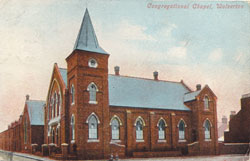 The Congregational Church in the Square, demolished in 1970. The site is now occupied by Foundation House and the URC Church. The Congregational Church in the Square, demolished in 1970. The site is now occupied by Foundation House and the URC Church.
|
|
Wolverton Bath House
Built in 1891 to replace the ones in Green Lane, the Baths on Stratford Road were built by the Railway Company between two of their workshops. It was designed to have 16 separate baths and it was hoped that swimming baths would be added later, but they never were. Today it houses the Living Archive.
|
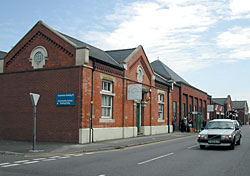 The Old Bath House, Stratford Road, now home to The Living Archive. The Old Bath House, Stratford Road, now home to The Living Archive.
|
|
Shops
In many purpose-built railway towns there is sometimes evidence of company-run stores which provide cheap items for workers. Here in Wolverton, documents suggest that the first shops were built within the Work’s grounds. Later, when the town was expanding in the 1850s, the railway company encouraged retailers to set up business in the town. Stony Stratford had been the original source of purchasable items until bakers, butchers, clothes outfitters and so on moved here. Walking down Stratford Road and Church Street it is still possible to see remains of original Victorian and Edwardian shop fronts, such as the shop formerly Fosters menswear on the corner of Stratford Road and Radcliffe Street. Maisie’s in Church Street occupies the former 1920’s Art Deco premises of the Co-op .
|
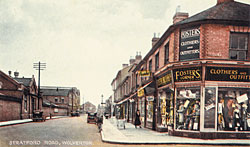 Fosters Corner at the junction of Radcliffe Street and Stratford Road looking east. Fosters Corner at the junction of Radcliffe Street and Stratford Road looking east.
|
|
The Fire Station
In around 1854, a much-needed fire brigade was set up for the Works. By 1896, it became the town’s fire brigade. The present 1911 LNWR purpose-built building was originally designed to have a clubhouse above it. The black ‘fire’ horses, Harry and Bessie, were trained to line up precisely for harnessing. A series of counterweights and pulleys opened the stable doors.
|
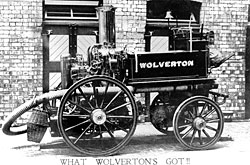 One of the Work's early fire engines One of the Work's early fire engines
|
|
Other Industries
There are a few firms that have survived up until today apart from the Works. The main one is McCorquodales, a printing and stationery firm that was persuaded by the Works to move here not only to provide employment for the female section of the town but also to print their timetables and publicity. It was originally on the north side of Stratford Road where the car dealers are now and expanded to the other side of the road in 1912. It later became the country’s leading manufacturer of banknotes and post office stationery. The new block of 1912 has a fine set of contemporary cast iron railings. It was extended to the rear in 1923.
|
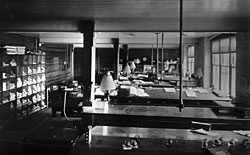 McCorquodales McCorquodales
|
|
Leisure
Wolverton Park Sports Ground, built by the LNWR to keep their workers fit, opened in 1885. By 1886 the cricket ground at Park was attracting large crowds. The Football Grandstand of 1899, still standing, is one of earliest in the country. At the end of end of the ground is a Park Lodge (1885) built to house the groundsman. The Wolverton Football Club was a very successful club at the turn of the century with the railway company offering jobs in the Works to good footballers. Part of the Park also houses a bowls club, the oldest in Buckinghamshire.
|
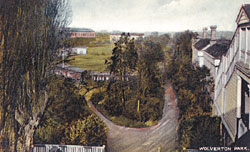 Wolverton Park seen from the Stratford Road with the now demolished station buildings on the right. Wolverton Park seen from the Stratford Road with the now demolished station buildings on the right.
|
|
Public Houses
There were four public houses in the town and three survive. The former Queen Victoria on the corner of Radcliffe Street and Church Street is now called Zaks. The Craufurd Arms on Stratford Road was originally a People’s Refreshment House, a semi-temperance hotel. The site of the North Western also on Stratford Road was bought by Mr Davies, the Stationmaster, and sold to a Newport Pagnell brewing firm in 1861 when the pub was built. The first landlord was previously a mechanic from the Works. On Sundays, the large back hall was used by the Congregationalists until their own chapel was built at the top of Market Square (demolished in 1970). The Royal Engineer (now the Greek Villager ?) i) is the only surviving pub contemporary to the Works when first built. It was built in 1841 opposite the then Works entrance. Along with The Queen Victoria (1860), the yards were used by ‘transport clubs’ to stable their horses and carts during the day. The aim of these clubs was to allow railway workers from the villages to share journeys and cost.
|
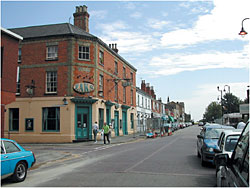 The Queen Victoria (Zaks) The Queen Victoria (Zaks)
|
|
Allotments
Land had been provided by the railway company in several places for the new townspeople to grow their own vegetables. Wolverton had one of the highest number of allotments per head of population in the country. Many sites disappeared when new housing estates (particularly Greenleys) were built but there are still two sizeable sites that continue to be used today.
|
|
|
Cinemas
‘Barber’s Electric Picture Palace’ facing on to Stratford Road was brought to Wolverton in 1911 in response to the huge workforce. It was powered by its own gas generator and the architecture both internally and externally suggests the links to the Works. The last film was shown in 1961 and it has subsequently been used as a bingo hall and a dance hall. After being saved from demolition in 1999, it is currently being used as a Pentecostal Church. The Asian Centre and Mosque at the east end of Church Street was originally a row of shops which were converted into a dance hall and then a cinema, The Empire, in 1926. It was closed in 1969 and used as a sorting centre for the post office next door.
|
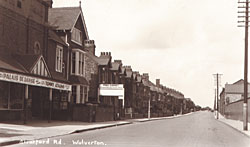 The former Barber's Picture Palace, Stratford Road, when it was a Palais de Danse. The former Barber's Picture Palace, Stratford Road, when it was a Palais de Danse.
|
![]()
![]()